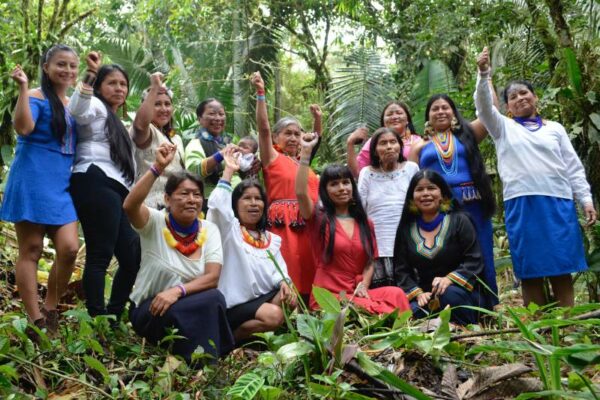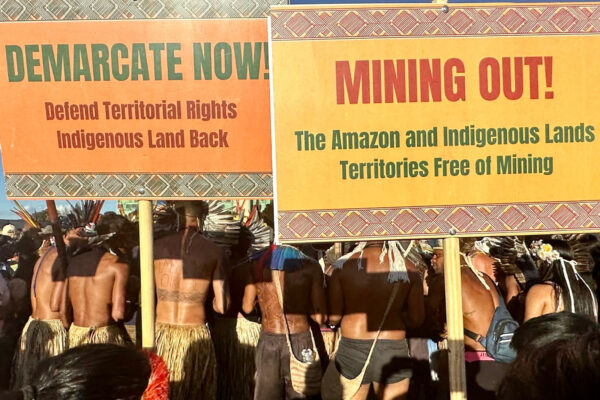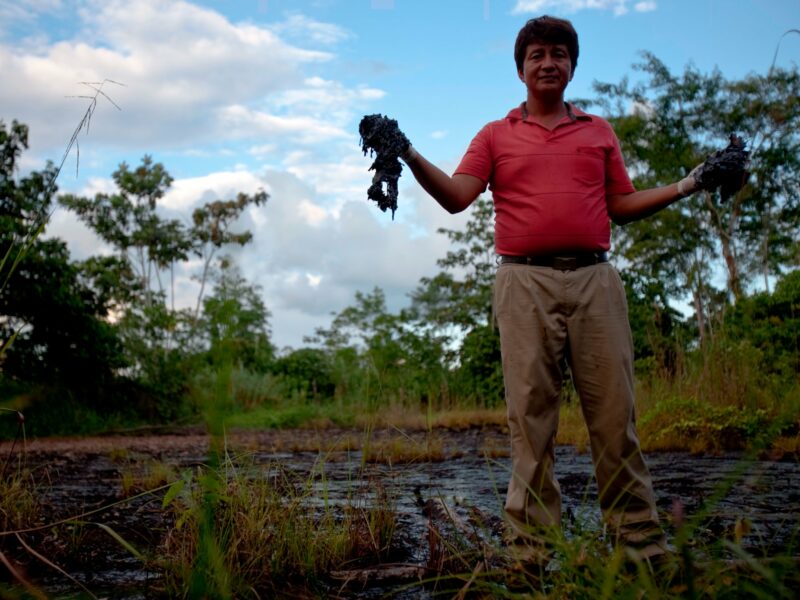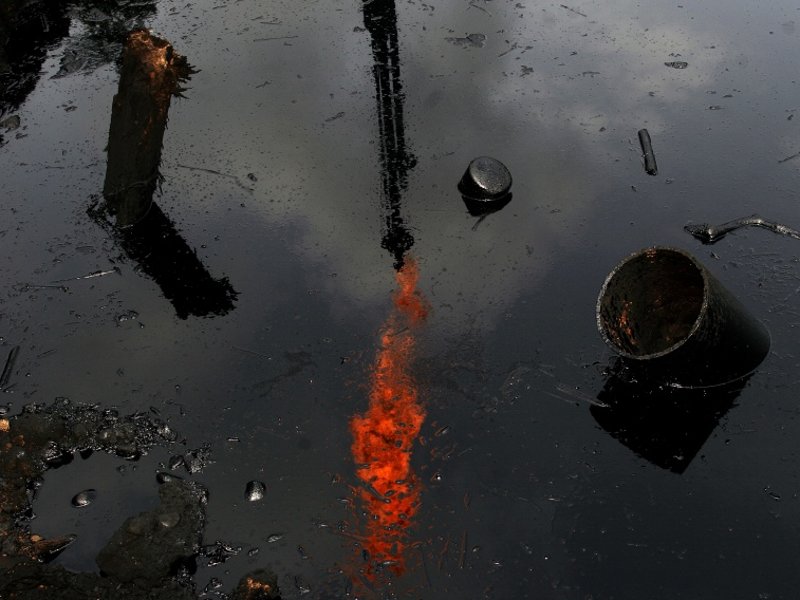
On March 4th, a federal judge in New York City blocked one of the richest and most scrutinized judgments in the annals of class-action law from being enforced on U.S. soil. The announcement of that decision, a closely watched event in legal and environmental circles, further muddied the future of $9.5 billion in damages the Ecuadorian Supreme Court in 2012 ordered the oil giant Chevron to pay for the systematic contamination of a patch of Amazon rainforest the size of Rhode Island. In his decision capping a seven-week trial, Judge Lewis Kaplan declared the Ecuadorian judgment null and void. The ten-figure fine, he concluded, was the fruit of a jungle shakedown – the result of a “five-year effort to extort and defraud Chevron.”
The oil company cheered Kaplan’s decision as “a resounding victory for [us] and our stockholders.” Steven Donziger, the warhorse lawyer for the Ecuadorian plaintiffs, decried the judge as an accomplice in “the biggest corporate retaliation campaign in history.”
The New York trial marked more than a possible turning point in the no-holds-barred battle-royale pitting Chevron against homesteading farmers and a union of five Amazonian tribes. It was also a surprise homecoming. More than a decade ago, the same court ruled to move the case out of New York, where the plaintiffs thought it belonged, and down to Ecuador, where Chevron had cozy relations with key officials in government. The subsequent seesaw between sovereign legal systems is uncommon. So too Chevron’s decision to counterattack the Ecuadorian decision using the RICO Act, a collection of racketeering laws usually employed in the prosecution of meth-dealing biker gangs and famous Italian crime families. Which isn’t to say Chevron’s RICO suit lacked Sicilian-accented echoes with mob cases. The oil company’s sole witness to its central charge of bribery was a corrupt Ecuadorian ex-judge named Alberto Guerra, whose entire family has been naturalized and relocated to northern California on Chevron’s dime. There, not far from the company’s corporate headquarters, the Guerra family lives on a $10,000 monthly stipend and a Chevron-supplied gated home and car. The entire case turned on the testimony of a witness living under a corporate protection plan. (Chevron has stated that the company has taken “reasonable measures, based on third-party assessments, to protect Guerra’s safety and security.”)
The RICO decision put another wrinkle in a case defined by unprecedented international sprawl. What began around the time of Bill Clinton’s first inauguration as a class-action suit filed in a New York court has ramified into an overlapping thicket of legal systems and mutual corruption allegations playing out from Buenos Aires to Gibraltar, from Washington D.C. to the Hague. So far, half a dozen legal authorities have been called on to adjudicate the main-event suit and its related cases. Law professors call it a “challenging paradigmatic interface,” but it’s best described as an extraordinary jurisdictional clusterfuck.
“This drama is in unchartered territory,” says Josh Galperin of Yale’s Center for Environmental Law and Policy. “We don’t have much to compare it to.” Marco Simons, legal director of EarthRights International, notes a disorienting, mildly hallucinogenic aspect. “We could be looking at an Alice in Wonderland scenario of never-ending litigation,” he says. “It’s hard to see where this ends.”

The man at the center of the case is 53-year-old lawyer Steven Donziger. He first visited the north of Ecuador as a young law school grad in the early 1990s and shortly after joined the Ecuadorian plaintiffs’ legal team at its inception in 1993. Donziger quickly emerged as its leader, or “cabeza.” Over the last 21 years, the case has dominated and directed his life in ways he could not have anticipated in law school, when he was playing basketball with Barack Obama and imagining a more conventional career in environmental and public interest law.
“Do you have any idea how crazy my life is?” Donziger asked me in the days following Kaplan’s RICO decision. “I don’t think anybody really understands what it’s like to be targeted by the full weight of a company like Chevron. They have private spies trailing my family everywhere we go. I had to hire a former FBI agent to prove I wasn’t crazy.” (Chevron denies these allegations.)
Donziger often voices incredulity over the wild swings and unremitting demands of the case that has made him famous and may yet make him wealthy. In interviews, he hits high notes of pride, defiance, righteousness, and, less often, bitterness. The only thing he never sounds, and cannot afford to be, is tired. His opponent is the second biggest oil company in the United States. It has sworn to fight him and his rainforest clients to the ends of the earth, which so far includes court systems and foreign offices on three continents. When it runs out of battlefield in this world, Chevron vows combat in the next – “until Hell freezes over, and then we’ll fight it out on the ice,” a company spokesperson said in 2009.
Staying in the ring against Chevron for two decades has required more than simple stamina. It has demanded of Donziger a fierce slow-burn resolve he has wielded in ingenious and self-defeating ways, a resolve that can tempt observers to invoke the well-intentioned mania of legendary gringos who came to the jungle to find glory and slay dragons with the locals only to be consumed by it. Like Amazon adventurers of a literary cut, Donziger brings a natural swagger to the job. It isn’t easy to imagine him sitting still for long, or discussing the case in anything but rhetorical machete slashes.
“Chevron has spent over $2 billion trying to wear us out and shut us down,” he says. “But I’m still here, I’m still happy, and the case will continue until we get justice.”
Kaplan’s March 4th decision doesn’t end Donziger’s quest, because no one judge has that power. The New York court only blocked Donziger’s clients from seizing their $9.5 billion settlement in the fifty states. But Chevron has billions tied up in liquid, resource and investment assets in countries where Kaplan’s decision has no legal standing. The action now moves to third-party countries like Canada, where a Chevron subsidiary is developing the Alberta tar sands. Donziger will try to seize these assets; Chevron will try to stop him. The Canadian Supreme Court is scheduled to hear Chevron’s objections in November. Donziger is also making aggressive moves against Chevron assets in Argentina and Brazil.

Chevron remains busy on offense, making defendants of the original plaintiffs, and their allies in novel ways. It is seeking $32 million in legal costs from Donziger to pay for the RICO trial (which Donziger is appealing) as well as damages from Donziger’s financiers, including the Gibraltar-based online gambling mogul Russell DeLeon. In May, Chevron forced the white-shoe D.C. lobbying firm Patton Boggs to remove itself from the case and settled for $15 million. Most brazenly, Chevron has forced the government of Ecuador before an arbitration tribunal and is seeking damages for allowing the original Ecuador trial to proceed. (This is the same trial Chevron initially demanded be held in Ecuador and not New York). Altogether, the oil company has sued five different lawyers representing the Ecuadorian communities, three of the lawsuits’ funders, a scientific consultancy, and the rainforest-villager plaintiffs themselves.
Chevron’s full-court press has been effective. So effective that Donziger could not pay his counsel during the RICO suit and relied on volunteers to match Chevron’s dozens of lawyers and their flurries of motions. This aspect of the proceedings was a rerun of the Ecuador trial, where, according to groups like Amazon Watch, Chevron’s lawyers tried to intimidate judges with jail time if they failed to grant motions that could be comically numerous: the company once filed 39 in less than an hour. Donziger’s attorney, the San Francisco trial lawyer John Keker, used his motion to withdraw as an opportunity to blast the court and its presiding officer, accusing Judge Kaplan of turning the case into a “Dickensian farce” with his clear pro-Chevron bias.”
“Through scorched earth litigation, executed by its army of hundreds of lawyers, Chevron is using its limitless resources to crush defendants and win this case though might rather than merit,” wrote Keker. “Encouraged by this court’s implacable hostility toward Donziger, Chevron will file any motion, however meritless, in the hope that the Court will use it to hurt Donziger.”
The logic behind Chevron’s take-no-prisoners strategy, say observers, has less to do with the company’s belief in its innocence in Ecuador than the sector-wide implications of conceding culpability and defeat. The decision handed down by Ecuadorian courts was a victory for a novel arrangement in environmental class-action law: a group of poor indigenous plaintiffs backed by a sophisticated coalition of U.S. lawyers, global finance, and foreign enforcement litigators. The success of this strategy jolted the entire oil and gas industry, whose players big and small face the same potential liabilities as Chevron.
“Chevron’s RICO case was aimed at discouraging poor communities and their advocates from trying to hold corporations accountable,” says Ginger Cassady of the Rainforest Action Network. “It sets a precedent for other corporations to follow when they want to beat back a challenge.” Donziger says the paradigm he pioneered “provided a path to success for communities around the globe who have billions in legal claims, but no resources.” Corporate America, he says, “is counting on Chevron to kill off this model for the future. Each time we get closer, they launch some other attack and move the goal posts back. They are trying to purchase impunity by running out the clock.”
Chevron can afford more than time. It can afford to buy the companies that make the clocks. If it succeeds in keeping the wheels of justice grinding in low gear until most of the plaintiffs are dead, it won’t be the first oil company to do this.
The one thing the company can’t outlive is the decades of toxic waste it dumped into the loams and waterways of northern Ecuador. Chevron does not dispute the presence of toxins – which are traceable to Texaco’s operation in the region, only their responsibility for them. While the layers of legal argument pile up, the scientific and ethical issues get drowned out, as do the voices of the indigenous communities living in toxic zones. “What gets lost in the twists and turns of this lawsuit is the only thing that matters,” says Mitch Anderson of ClearWater, a NGO that works to provide clean water to the affected communities. “The people of the Amazon continue to grow crops out of contaminated soil and bathe in contaminated rivers.”
To avoid what has become a perennial face-to-face confrontation with these tribes-people and their supporters, Chevron this year relocated its Spring shareholder’s meeting from San Francisco to a petroleum museum in the oil and gas town of Midland, Texas – ground zero of America’s fracking boom and a solid desert in every direction away from the nearest city. Midland is a fittingly remote bolthole for Chevron to hide from challengers to its power and arrogance. Ecuador’s first encounter with this arrogance began in an even more remote location: the formerly pristine rainforest region that Ecuadorians call El Oriente. The encounter started like so many oil stories, with a military dictatorship newly installed and hungry for hard currency and development at any cost.

In the mid-1960s, the Texaco Petroleum Company partnered with Ecuador’s military junta to drill for oil in the raw jungle of the country’s northeast, near the Colombian border. For more than three decades, a Texaco subsidiary called TexPet built and managed more than 350 drill sites on land populated by five local tribes and a smattering of migrant farmers. Along with a lot of oil, these wells produced an estimated 16 billion gallons of toxic runoff, including so-called “formation waters” rich in heavy metals and carcinogens like arsenic, chromium and benzene. TexPet took full advantage of lax laws and oversight. Some of the waste was funneled into shallow pits; much more was dumped directly into rivers and the jungle floor. As for the crude itself, a Texaco memo from 1972 instructed workers to report only spills that “attract attention of the press and/or regulatory authorities.”
Texaco ended its Ecuador operation in 1992. When it handed management of some of its drill sites over to the state oil company, Petroecuador, the region was dotted with an estimated 1,000 waste pits near drinking and fishing waters. Two internal audits prepared during Texaco’s departure painted a dismal and unapologetic picture of its environmental legacy.
It was around then that Donziger first visited the area. A former Central America UPI correspondent and a newly minted lawyer, he toured TexPet’s former sites with an American-born Ecuadorian lawyer who was then exploring possible legal action. “I simply couldn’t believe that an American company could treat people the way Texaco had,” says Donziger. “I couldn’t shake the images from my mind.” In 1993, the Ecuadorian-American lawyer filed a class-action suit in New York. Donziger joined a legal team of three.
Texaco argued that the trial should be moved to Ecuador, where its partners were still in power and the company had reason to expect a sympathetic hearing. Donziger’s team argued the trial belonged in New York, where Chevron is publically traded and where both sides could expect a fair trial. It would take a Second District judge in New York nearly a decade to decide the jurisdiction question. While the court deliberated, Texaco attempted to cover itself. It spent $40 million cleaning up a portion of its drill sites in exchange for a settlement agreement with Ecuador that protected against future government claims. Those living in the contaminated area watched as Texaco tried to cover its tracks, literally in some cases, by sprinkling dirt over shallow oil pits. An Ecuadorian government agency later found contamination in 85 percent of the supposedly “remediated” sites. Two Quito-based Texaco executives and seven Ecuadorian officials were eventually indicted on fraud charges.
When the suit was filed in New York, many of the hardhats from Texas and Louisiana that built and managed Texpet’s operation were dead. So were the CEO, Augustus “Gus” Long, and the leaders of the junta who in 1973 made Ecuador the newest, tiniest member of OPEC. Texaco hadn’t expired so much as gained new life when it was absorbed by Chevron in October, 2001. But Chevron today describes this merger as a kind of corporate death. In conversations about the lawsuit, its spokespeople always open by saying, “It is important to note that Chevron has never operated in Ecuador.” This disavowal of Texaco’s liabilities is unmatched by disavowals of Texaco’s assets, which made Chevron the second biggest oil company in the country.
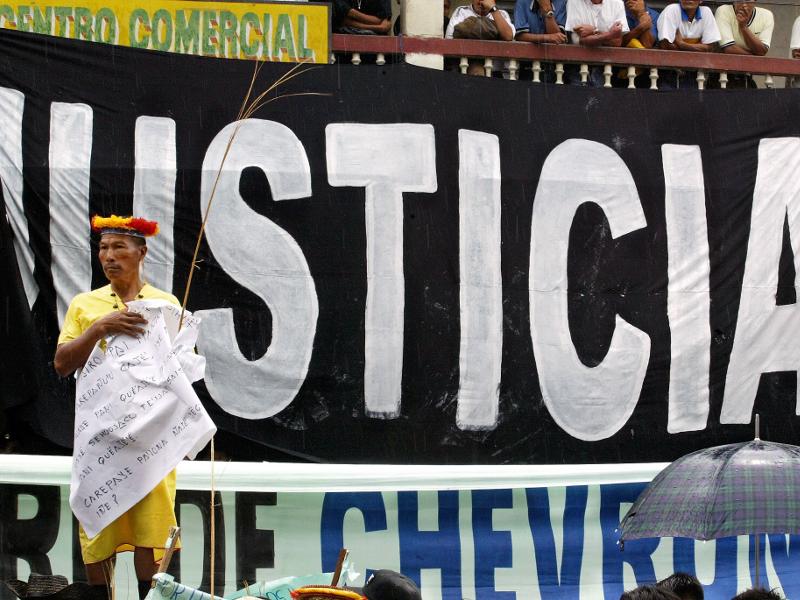
A U.S. federal judge in 2003 granted Chevron’s request to move the trial to Ecuador. By then, Texaco (and later Chevron) had filed 14 sworn affidavits praising Ecuador’s court system. Donziger, now the head of the legal team, resubmitted the suit to a provincial courthouse in Lago Agrio, which quickly announced the first order of business: tests to determine the scope of the alleged contamination. During the next four years, the parties to the suit and outside groups filed more than 60,000 lab results from more than 100 contested sites. They overwhelmingly showed contamination traceable to Texaco.
Evidence submitted to Kaplan’s court during the RICO trial make clear that throughout the evidence-gathering process, both sides distrusted the other, worried about the results, and took steps to shade the results in their favor.
Among Kaplan’s judgments related to discovery was allowing Chevron access to Donziger’s private notebooks and correspondence. In one diary entry, Donziger admits to setting up secret bank accounts to make payments to an independent court-appointed expert. He refers to the relationship as a “bargain with the devil,” necessary but insufficient to defeat a larger and much more corrupt foe. “We can’t win with the devil b/c they [Chevron] can always pay more,” he writes.
Chevron did indeed “pay more” during the sampling process. Documents acquired by Donziger’s team claim a scheme in which Chevron shielded “dirty samples” from the court by sending them to friendly labs. The company also issued “playbooks” guiding inspectors away from contaminated soil. “Chevron conducted several inspections at each site months before each judicial inspection,” says Nathalie Cely Suárez, Ecuador’s ambassador in Washington. The company’s manipulation and cherry-picking of the sampling process, she says, was “systematic.”
We don’t know everything about the soil-and-water testing phase of the trial. But we do have hours of recorded conversations between Santiago Escobar, an Ecuadorian living in Toronto, and a Chevron contractor named Diego Borja.
Borja was already part of the Chevron extended family when the company hired him to transport coolers containing the company’s field samples to supposedly independent labs. His uncle, a 30-year Chevron employee, owned the building housing Chevron’s Ecuadorian legal staff. As he carried out his work, Borja collected more than one kind of dirt. In recorded calls to Escobar in 2009, Borja explained how Chevron’s Miami office helped him set up front companies posing as independent laboratories. (Among his Miami bosses was Reis Veiga, one of the lawyers indicted for corruption in the 1997 Texaco remediation settlement with the Ecuadorian government.)
Borja contacted Escobar because he thought his information might be valuable to the other side. “Crime does pay,” he told Escobar. In the calls, Borja suggests Chevron feared exposure and prosecution under the Foreign Corrupt Practices Act. “If [a U.S.] judge finds out that the company did cooked things, he’ll say, ‘Tomorrow we better close them down,’ you get it?” He boasted of possessing correspondence “that talks about things you can’t even imagine … things that can make the Amazons [plaintiffs] win this just like that.” In awe of Chevron’s power, Borja said the company has “all the tools in the world to go after everyone. Because these guys, once the trial is over, they’ll go after everyone who was saying things about it.” Still, the benefits of working with them were great. “Once you’re a partner of the guys,” he told Escobar, “you’ve got it made. It’s a brass ring this big, brother.”
Borja’s brass ring was ultimately worth over $2 million. Sometime around 2010, he was naturalized at Chevron’s expense and moved into a $6,000-a-month gated community near Chevron’s headquarters in San Ramon, California. Why the company finds his loyalty worth so much is hard to say, because Judge Kaplan blocked further discovery. When asked if Borja is still being paid by the company, Chevron spokesman Morgan Crinklaw said, “Not as far as I know.”
“Kaplan gave Chevron unlimited access to our files,” says Donziger, “but allowed them to maintain a complete iron curtain of privilege over everything related to the misconduct of non-attorneys like Borja and its network of espionage operatives.”
Chevron maintains there is nothing behind this iron curtain. “Borja is a distraction from the real issues,” says Chevron’s Crinklaw. The company gives a similar answer when asked about the new American life it has provided Alberto Guerra, who Donziger claims is its sole witness to the alleged bribery scheme that anchors Kaplan’s decision in the RICO trial.
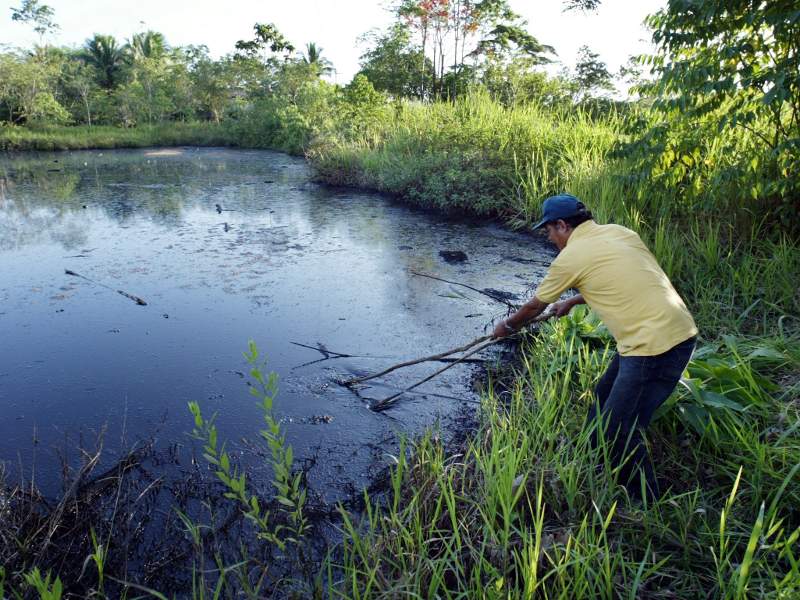
Despite likely tampering, the results of extensive soil and water testing left no doubt: widespread contamination pointed to Texaco. The scientific results were soon overshadowed, however, by Chevron’s allegation that Donziger’s team “ghostwrote” the court-issued report summarizing the findings. The allegations centered on secret payments to the report’s author, Diego Cabrera; this was Donziger’s “bargain with the Devil.” Cabrera had indeed been paid $120,000 by Donziger’s team, and the report he issued was written by the Boulder-based environmental consultancy Stratus. Chevron maintains its evidence is proof of a larger fraud. The plaintiffs point to the scientific substance and credibility of the report as well as standard legal practice. In Ecuador and the U.S., it is common for trial parties to submit papers and model judgments for consideration and, they hope, adoption by the court “in toto.”
“The highest compliment in any judicial proceeding is that the court uses a study wholesale,” says William Powers, an environment engineer who subcontracted with Stratus. “You have to get into the merits to evaluate the Stratus report, and Chevron wanted to avoid getting into the merits, so they focused on Cabrera and Donziger’s notebooks.”
According to Donziger, Chevron pressured Stratus’s insurers to drop coverage, its clients to cancel contracts. Powers also claims that Chevron asked the U.S. government to withdraw its certification, which would have put the firm out of business. Stratus refused to give in and prepared to mount a counter suit. But the firm was no match for Chevron. Facing bankruptcy after a years-long campaign, Stratus relented. In April of 2013, its executives signed cooperation agreements prepared by Chevron and issued a mea culpa recanting portions of its work in Ecuador. “They hated to throw us under the bus, but Chevron had them over a barrel,” says Karen Hinton, a longtime publicist with Donziger’s team.
Stratus’ partial recantation resulted in a public relations windfall for Chevron. “Plaintiffs’ Experts Say ‘No Evidence’ For Billions In Damages Against Chevron,” ran a headline in Forbes. The rest of the business press, which sets the tone for coverage of the case, followed suit.
Chevron needed the win. For years, the company had struggled with a coherent and effective media strategy to counter the other side’s stark narrative ripped from the Old Testament: poor natives and a plucky American lawyer (David) demanding justice from Big Energy (Goliath). In a memo from 2008, a Chevron media consultant named Sam Singer blasted the company’s flat-footed media game and advised it to avoid discussing the environmental and legal complexities of the case. Instead, he suggested Chevron paint Ecuador and its newly elected leftist government red, and describe the country as “the next Cuban missile crisis in the making.” And since the evidence cut against the company, why not sow doubt over its ontological status? “Is the case against Chevron really a novel by John Grisham? What appears to be real is in fact a front for something else,” Singer advised Chevron to tell the public.
The flap over the Stratus-Cabrera report didn’t just give Chevron a win. It illuminated a new strategy moving forward. By using its enormous resources to pressure Donziger’s allies and funders – as well as the allies and funders of his allies and funders – the company might destroy its challenger indirectly, by cutting off its oxygen supply. Chevron has since gone after Donziger’s allies by suing and naming them (or threatening to sue and name them) as “non-party co-conspirators” to a criminal enterprise.
“It’s an intimidation model,” says Deepak Gupta, Donziger’s lead appellate lawyer. “It’s a way for corporations to go after their critics and those who fund them.”
Chevron denies an interest in anything other than justice, for itself and for the parties behind what Chevron’s Morgan Crinklaw calls an “intricate, complex scheme to use Ecuador’s judiciary to try and hold Chevron’s reputation hostage.” To undermine this “scheme,” Chevron has gone after everyone on the other side, from Donziger down to his volunteers. “If someone is going to participate in fraud,” says Crinklaw, “they should be held accountable.”
One entity Chevron never expected to be “held accountable” in Ecuador was Chevron. What happened?

In 2006, Rafael Correa was elected president of Ecuador. It was a development Chevron could only have viewed with alarm. A leftist aligned with Hugo Chavez, Correa came to power denouncing Washington’s historical role in the region. After visiting the affected regions in the northeast, he publically stated his support for the lawsuit against Chevron.
With one election, the political situation in Ecuador became a negative print of the one Texaco faced in 1993.
Without the ability to influence the government in Quito, Chevron turned to Washington. Documents acquired by the legal blogger Theodore Folkman show how the company lobbied the Bush administration to use trade-policy as a weapon on its behalf. Folkman reported in April 2007 that Chevron CEO David O’Reilly asked the State Department’s Undersecretary for Political Affairs if “there was a way for the USG to help Chevron and to level the playing field.” Other memos record Chevron inquiries about using trade policy “as a tool.” These efforts sparked three Congressional letters of protest, including one by then-Senator Barack Obama to Ambassador Rob Portman seeking his assurance “that the U.S. Trade Representative will not allow negotiations over the Andean Free Trade Agreement to interfere with a case involving Chevron.”
“The scale of what Chevron did to weaken support for trade policies designed to help poor people is outrageous,” says Ecuador’s ambassador in Washington. “They were trying to take hostage thousands of jobs in both countries, most of them done by poor women.”
As Chevron worked Washington, Donziger, a natural born publicist, continued to work the media. He brought journalists and celebrities to visit Texaco’s old drilling sites and waste pits, among them Sting, Roger Waters, Brad Pitt and Angelina Jolie. In 2007, CNN honored one of Donziger’s Ecuadorian colleagues, Pablo Fajardo, with an award and a nationally televised speech. As awareness of the case grew, Chevron was lucky not to drool on itself in public. One of its lobbyists told Newsweek in 2008, “We can’t let little countries screw around with big companies like this.”
Then came Crude, Joe Berlinger’s 2009 documentary about the case. The film told the story of Donziger and his local clients through a sympathetic lens against searing images of chemically trashed jungle and sick Indians. It was like a PR finishing move. How could Chevron hope to match it?
In retrospect, its importance to the case is rivaled by a less sexy piece of media that appeared in law offices around the country during Crude‘s festival run.
The October 2009 issue of American Lawyer magazine profiled the success of New York corporate law firm Gibson Dunn in defeating an environmental class-action suit filed by Nicaraguan fruit pickers against the Dole Food Company. It was a case with several parallels to Chevron’s situation in Ecuador, in which Dole sought to reverse a judgment reached by Nicaraguan courts through a court in Miami. Chevron had been following Gibson-Dunn’s work on the Dole case and had hired the firm the previous summer to take over its defense.
The firm’s first breakthrough on Chevron’s behalf came fast. One of its team noticed small discrepancy between two released versions of Crude. The lawyer successfully used this variance to launch a massive discovery search that spanned more than 20 federal courts and netted thousands of Donziger’s emails, his personal diary, and 600 hours of Berlinger’s outtakes.
Chevron’s request for access to the raw Crude footage led to an outcry by an alliance of media companies including the New York Times, the Washington Post, and the Associated Press, who together signed an amicus brief submitted to the court in New York. Judge Kaplan dismissed these concerns in a statement released during a national conference of documentary filmmakers. Among those in attendance was Gasland director Josh Fox, himself a veteran of battling the oil and gas industry.
“When we heard about Kaplan’s order, a chill shot through the room,” says Fox. “The implications for the First Amendment, for reporter’s privilege – it horrified everyone.”
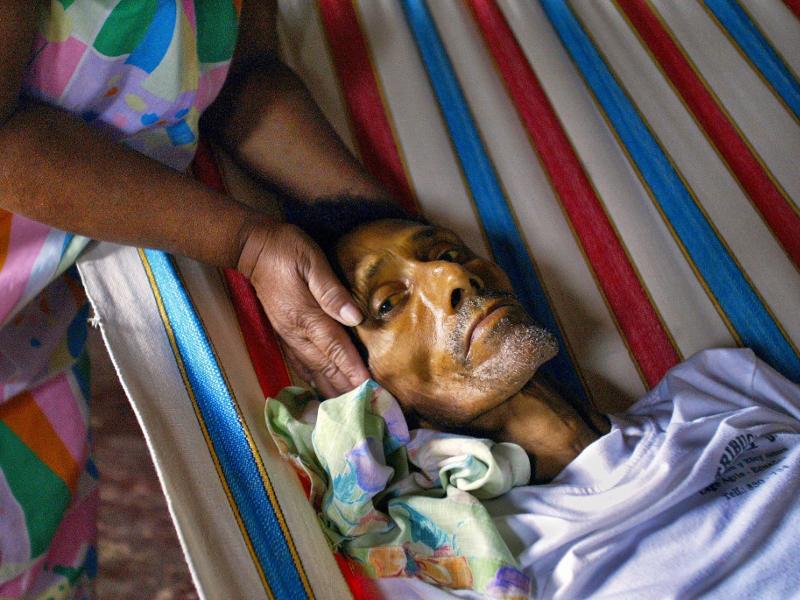
On Valentine’s Day, 2011, Judge Nicolás Zambrano of the Lago Agrio court found Chevron liable for $19 billion in damages. (The Ecuadorian Supreme Court upheld the decision, but reduced the amount by half). Zambrano did not cite the controversial Cabrera-Stratus report. He didn’t have to. In eight years of litigation, both sides had submitted more than 215,000 pages of evidence and more than 100 technical reports to the court.
On the day the decision was issued, Chevron had moved beyond concern over the Cabrera report to more serious allegations. Specifically, it accused Donziger in federal court of promising Zambrano $500,000 to ghostwrite the decision. After first arguing the case should not be tried in New York, Chevron now turned to asking the same Southern District of New York court to overrule the Ecuadorian decision.
In the RICO decision delivered in March, Kaplan obliged. He accepted Chevron’s argument that Zambrano, a provincial judge who mostly handled criminal cases, could not have written the complex judgment he issued against Chevron. Kaplan cited the fact that Zambrano’s only assistant was an 18-year old typist who spoke no English. Moreover, Zambrano had admitted in the past to paying other judges to write his decisions. Kaplan also cited “fingerprints” (typos, idiosyncratic numeralization, etc.) that led back to documents on the plaintiffs’ computers he believed had never been introduced to the court record.
Chevron’s central piece of evidence was the testimony of Alberto Guerra, a former judge who has admitted to corrupt dealings over the course of his own career on the bench. Guerra first approached Chevron about helping the company in 2009. As noted above, Guerra now lives with his family in California on Chevron’s payroll. Company documents show that Chevron pays Guerra a generous monthly stipend on top of living costs in a gated community near Chevron’s headquarters.
Chevron maintains that it has no choice but to protect Guerra, since his testimony puts him in danger in Ecuador. “Guerra had to be relocated,” says Chevron’s Morgan Crinklaw. “He is not being paid for his testimony [and saying otherwise] is a desperate attempt to try and diminish him.”
Donziger believes the appellate court in New York will disagree and overturn Kaplan’s decision. Guerra lacks credibility as a witness, he says, and the “fingerprints” on Zambrano’s decision resulted not from “ghostwriting,” but from actions in accordance with accepted legal practice.
“Zambrano’s decision wasn’t ‘ghostwritten’ any more than Kaplan cribbed his facts and arguments from Chevron’s RICO briefs,” says Donziger. “[Zambrano] took materials and pleadings submitted to the court and adopted them in his decision, sometimes by copying them, which is entirely proper in both Ecuador and the U.S. Some of the documents we submitted to the court never made it into the official trial record because of clerical errors. We have an explanation for every specific Chevron allegation.”
The views of a New York Appeals Court for the Second Circuit may be of less moment than those of judges in foreign courts. In Canada, where Chevron holds billions in tar sands assets, the first stage of an enforcement trial (establishing jurisdiction) has already reached the Supreme Court. Wheels are also turning in the court systems of Brazil and Argentina.
Chevron meanwhile is enjoying boom times. The company’s earnings have grown by nearly 40 percent since 2010, the year BP’s value nosedived in the wake of the Gulf oil and a subsequent $26 billion cleanup. “Chevron made $4.9 billion in the fourth quarter of 2013 alone,” says Daniel Graeber, an analyst at OilPrice.com. “It can afford to wage a very long legal fight.”
As it wages that long fight, everyone involved – Chevron’s lawyers, Donziger, the people in the Amazon – get older. Among this large cast, it’s the farmers and the Indians, not the lawyers, who continue to struggle daily with the 50-year legacy of oil production in the region. It’s possible they will all go to their graves before the case is settled and the contamination remediated.
Donziger knows this. But he sounds like he believes himself when he says he’ll live to see justice for his clients, even as Chevron takes advantage of what he admits were his own mistakes, and picks off his allies and funders, one by one. Part of his strategy is to keep the world’s attention on the merits of the original suit. A business journalist is writing a book about the case from Chevron’s perspective, and he’s fishing for someone to write its opposite. He also thinks there’s another documentary to be filmed that brings the story up to date. If it never gets produced, it won’t be because Donziger lacked an elevator-pitch.
“This battle has all the intensity and grind of a high-stakes litigation combined with the daily give and take of a hotly contested political campaign,” Donziger told me in April, as if speaking to a studio head.
“Except there is no election day,” he continued, deflating a little. “It just goes on and on and on. I’m waiting for that one judge in an enforcement court to force Chevron to comply with the law. I think that day will come. I think it will come far sooner than Chevron believes.”


